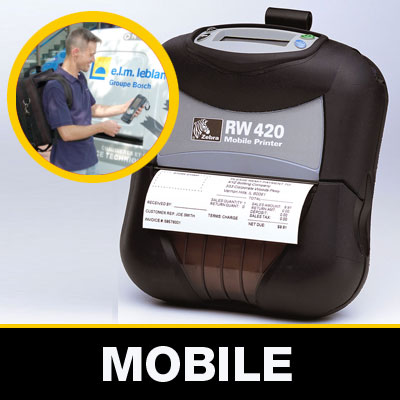Enjoy benefits and new preview !

Mobile Workforce LeBlanc
Enhancing mobile engineer reliability with Zebra® printing solutions
Founded in 1932, e.l.m. leblanc, a subsidiary of the Bosch Group, is a benchmark brand for gas heating and is one of the main operators in the heating sector in France. From the very outset, e.l.m. leblanc has always adopted the same philosophy: innovation through combining experience with advanced technology, while preserving easy maintenance and use.
Since 2004 e.l.m. leblanc maintenance engineers have been using mobile IT technology to: input information on call-outs made, printing call-out reports, invoicing, quoting and even proof of payment by bank card. The second generation of devices, including the Zebra RW 420 series mobile printer, has contributed to overall improvements in terms of performance, ergonomics and technical expertise.
The Challenge
- To make the maintenance engineers’ equipment more reliable
The Solution
- Zebra RW mobile series printers, with PDA and bar code reader.
The Benefits
- Better quality printing
- Faster print speeds
- Improved stand alone operation
- More robust
- Easy-to-use
- Better return on investment (ROI)
Against this background of constant service improvement that is provided to its customers, e.l.m. leblanc launched a mobile IT project in 2002, aimed at equipping its 300 maintenance engineers with an IT device kit comprising a PDA, portable printer and bar code reader. Using these tools, engineers can access dedicated applications, allowing them to consult their call-out schedule, synchronised with their PDA every morning, as well as information about customers, previous visit histories of each customer and boiler maintenance record information. They can also access the price catalogue and an inventory of the spare parts in stock. During each customer visit, the mobile application is used to record the type of call-out performed, the parts that have been replaced, all of which are entered using the bar code reader. They can then print out a call-out report, an invoice, quotation and proof of payment by bank card.
The Benefits
Having received several awards for its innovation, this mobile application has allowed e.l.m leblanc to make substantial back-office savings, by avoiding having to input call-out reports twice, which were previously sent by fax. This makes the information even more reliable by avoiding the mistakes which naturally arise with inputting reports twice. With its engineers carrying out almost 300,000 call-outs per year, the company estimates that it has made savings of EUR 500,000 per year.
Furthermore, the time taken in between the call-out and inputting the report into the computer system used to take around 20 days, which made it difficult to analyse after-sales service activities. This mobile IT project has also made it possible to automate the process for restocking engineers with spare parts, thereby reducing the stocks available, while also improving logistics for both call-out engineers and customers. Another benefit derived from the project is that it has elevated the role and work done by engineers. “They are not viewed just as handymen,” confirms Eric Payan, Director of Marketing Information Services, “They now enjoy the status of an e.l.m. leblanc specialist.”
Next generation equipment offering better ergonomics
Thanks to its success, the project’s ROI took an impressive less than 2 years. By the end of 2006 e.l.m. leblanc realised that standard PDAs were no longer adequate. “We decided to look at a replacement solution for our entire stock of mobile IT devices,” continues Eric Payan.
The company decided to opt for more robust devices as the standard PDAs that were currently being used could not be taken out of the toolbox because they were too fragile. “These devices were not robust, so we had developed a special foam packaging to protect them in the engineers’ toolbox, which also included their traditional tools and spare parts,” explains Eric Payan.
“Given this situation, more robust printers were a key requirement,” he adds. “We tested 6 mobile printers in total. The Zebra RW 420 mobile series printers came out on top. They achieved the best results by far in all our tests in terms of robustness, print speed and quality, standalone operation and ease-of-use.”
Easy-to-use, lighter to carry and an excellent stand alone operation e.l.m leblanc was also pleased about how easy it was to start using these new devices. Training was carried out in May and June 2007, with a mere half a day being sufficient for all its engineers. The applications have been simply adapted between the first and second generation devices.
Apart from being more reliable and easier to use, e.l.m leblanc engineers have also benefited from the new robust mobile devices being more convenient to use. The weight of the entire kit they carry around including tools, spare parts and IT equipment used to weigh a hefty 17 kilos. By using the new robust Zebra mobile printers, this has now been reduced by 5 kilos. In addition, the hard case has been replaced by a soft bag, which users can carry more comfortably on their back by using a strap, or even on their shoulder. By consisting of several removable sections, this means elements of the toolbox can be removed as necessary. The engineers therefore benefit from it being more ergonomic to carry. Being small and compact, the Zebra mobile printers can also be clipped to the engineer’s belt.
Customer feedback has been very positive. Engineers can move around more freely and documents are printed out much more quickly for the customer whilst maintaining a high quality.
The new system has also further reinforced and improved the engineers’ status as specialists, allowing e.l.m leblanc to further consolidate its reputation as an innovative company.
Register to the Newsletter
ZEBRA Technologies
First 100% Zebra online store
The myZebra site is the online sales platform from ECE,
a specialist of Zebra products.
ECE has no tied what so ever to Zebra Technologies Corporation.














